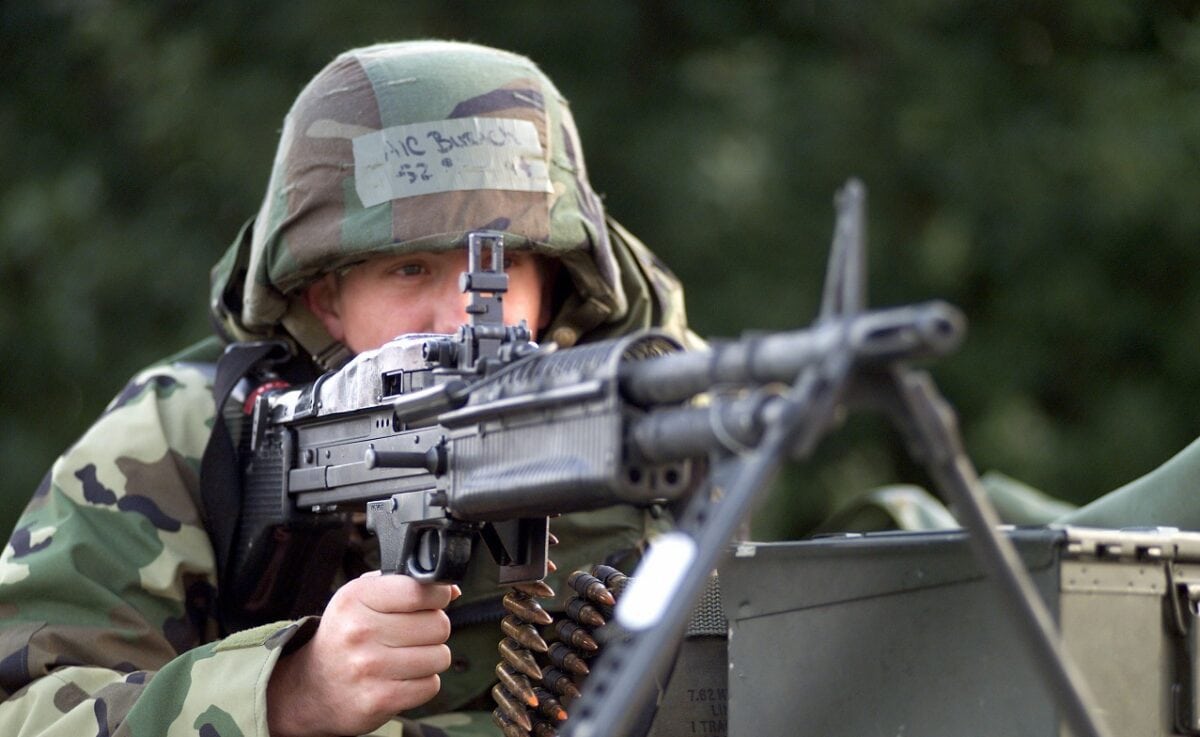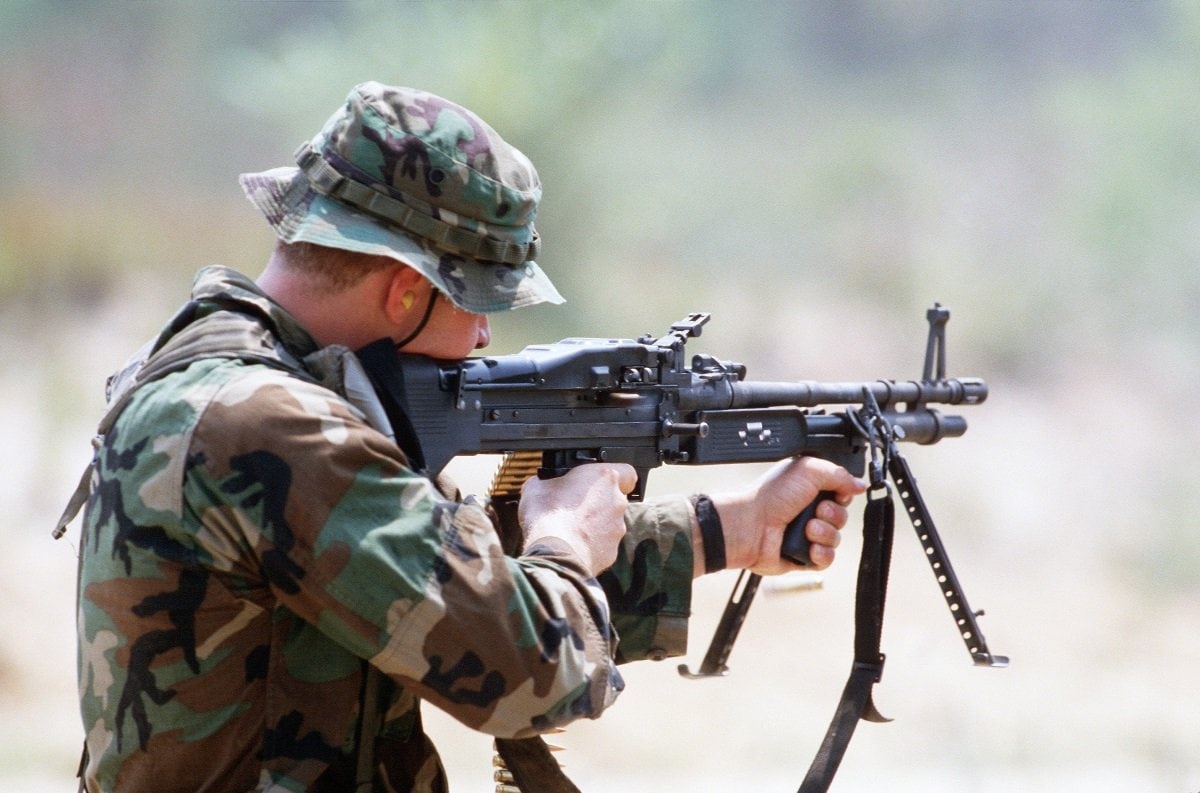One good M60 article deserves another. Likewise, one good “Pig” article deserves another. Having already published an article on one M60 – as in the M60 Patton main battle tank – and with an article on one “Pig” publication – as in the F-111 Aardvark jet fighter-bomber – it only makes sense for us at 19FortyFive to now turn to a weapons system that has both the M60 and “Pig” labels, though admittedly only the former label one is official whilst the latter is a decidedly unofficial nickname: the M60 7.62x51mm NATO general-purpose machine gun (GPMG).
If you served in a Combat Arms career field within any branch of the U.S. Armed Forces between the late 1950s and early 2000s, you’ll recognize the M60, Even if you didn’t serve in the military, you’ll still recognize the gun if you’re fan of either 1980s action films like Rambo and Commando and/or Vietnam War movies like Stanley Kubrick’s Full Metal Jacket; regarding the latter movie, who could forget Adam Baldwin’s “war face” as Animal Mother, or Tim Colceri as the helicopter door gunner in the iconic “Get Some!” scene?
A Pig Is Born
The gas-operated, belt-fed, air-cooled M60 is actually partly derived from a WWII Wehrmacht machine gun, the fearsome MG-42 AKA “Hitler’s Buzz Saw.”
The weapon was designed in 1952 and initially manufactured by Saco Defense; which was acquired in 2000 by General Dynamics; subsequent to that acquisition, U.S. Ordnance of Reno, Nevada, took over manufacture.
The U.S. Army officially adopted the weapon in 1957, initially intended as a replacement for the battle-proven Browning Automatic Rifle (BAR). The M60 later served in the Vietnam War as a squad automatic weapon, and it was in that conflict that both the positives and the negatives of the gun’s reputation were established.
American grunts had a love-hate relationship with one; some swore by it, others swore at it. The late great military historian Robert F. Dorr – himself an Air Force veteran – elaborated back in 2013:
“They loved its reliability and rate of fire but disliked its bulk, which earned it the nickname ‘the Pig.’ Changing the barrel on an M60 was an awkward, cumbersome task, all but impossible in the heat of battle. Former U.S. Army Staff Sgt. Steve Beasley, a firearms authority, said the M60 is ‘iconic as a general-purpose light machine gun,’ but had many flaws.
‘It had some good features,’ said Beasley in a telephone interview with 19FortyFive. ‘It had many that weren’t so good.’’
Some of features in the “weren’t so good” category: early models suffered from “receiver stretch,” a problem with the receiver-trunnion block weld; in addition, stamped aluminum feed tray covers could be damaged fairly easily, often taking the weapon out of action.
For better and for worse alike, the M60 soldiered on for several decades, until the Army started phasing out the gun in favor of the M240 in the early 1990s, and the sister services began following suit for the most part shortly thereafter. However, the M60 is still lingering on with the U.S. Navy, specifically with the SEALS and as part of the SH-60 Seahawk helicopter’s armament package. Reportedly some U.S. Coast Guard units still have them as well.
Personal Shooting Impressions (Secondhand, That Is).
During my 7 years of active-duty service in the U.S. Air Force Security Forces (HOOAH!), I never got to fire the M60, though I did get to fire the M240B, and even got to hump the latter beast during Military Operations in Urban Terrain (MOUT) training at Camp Bullis, Texas (a whole ‘nother story in and of itself). To give you an idea of the timeframe, when I went through the enlisted Security Apprentice Course in 1999-2000, USAF SF still had the ’60, but by the time I got to the Security Forces Officer Course in 2004, the 240B had taken over.

U.S. airman with an M60, assigned to the 52nd Security Forces Squadron (SFS), at Spangdahlem Air Base (AB), Germany.
So then, since, unlike with most of my gun articles, I don’t have firsthand shooting experience to write about, I shall instead draw off of one of my former comrades-in-arms who did get to wield the weapon. My friend Bret Wallace – now a retired USAF Master Sergeant (MSgt/E-7) with 23 years of honorable service – was a 60-gunner with my unit back when he was a Senior Airman (SrA/E-4) and I was a mere lowly humble Airman 1st Class (A1C/E-3) safeguarding Minuteman III nuclear ICBMs at the frozen tundra of Minot AFB, North Dakota. Here’s what Bret had to say about his M60 experience:
“I sure was, that was my baby. It sucked to carry 800 rounds while doing a recap [recapture exercise of a missile launch facility (LF), that is] from 400 meters out. I loved that thing though, never had an issue when I would fire that thing, maybe just my luck.”

A Sea-Air-Land (SEAL) team member fires an M60 lightweight machine gun from the shoulder during a field training exercise.
So, You Want Your Own M60?
Believe it or not, American civilians can legally purchase an M60, though of course internals have been extensively modified to make it essentially impossible to convert them to fire in fully automatic. Assembled by Desert Ordnance of McCarran, Nevada, a semiauto-only ’60 is currently listed on the Mockingbird Precision website for a mere $15,500.00 USD, a whopping $500.00 savings over the regular $16K price. So, if you’ve got that much spare money burning a hole in your pocket and nothing better to do with it, hey, go ahead, what’ve you got to lose?!
MORE: The F-35 Now Comes in Beast Mode
MORE: Why the U.S. Navy Tried to Sink Their Own Aircraft Carrier
Christian D. Orr has 33 years of shooting experience, starting at the tender age of 14. His marksmanship accomplishments include: the Air Force Small Arms Ribbon w/one device (for M16A2 rifle and M9 pistol); Pistol Expert Ratings from U.S. Customs & Border Protection (CBP), Immigration & Customs Enforcement (ICE), and the Federal Law Enforcement Training Center (FLETC) Criminal Investigator Training Program (CITP); multiple medals and trophies via the Glock Sport Shooting Foundation (GSSF) and the Nevada Police & Fires Games (NPAF). Chris has been an NRA Certified Basic Pistol Instructor since 2011. In his spare time, he enjoys (besides shooting, obviously) dining out, cigars, Irish and British pubs, travel, USC Trojans college football, and Washington DC professional sports.

